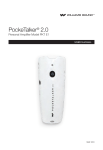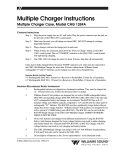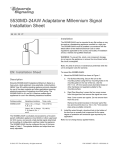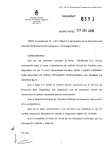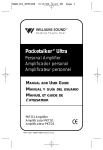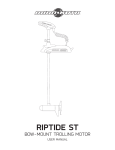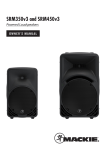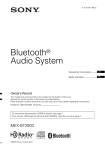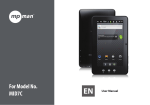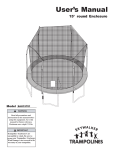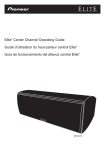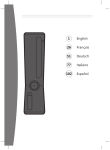Download Pocketalker® 2.0
Transcript
English Pocketalker® 2.0 Personal Amplifier Model PKT 2.0 USER Manual MAN 181E 1 Contents English Safety Warnings���������������������������������������������������������������������3 Overview��������������������������������������������������������������������������������5 Included Items������������������������������������������������������������������������5 Getting Started�����������������������������������������������������������������������6 Recharging NiMH Batteries��������������������������������������������������10 Listening during conversations with others���������������������������11 Extending the Microphone����������������������������������������������������12 Using an Optional Neckloop�������������������������������������������������13 Using the Lanyard����������������������������������������������������������������14 LED Indicators����������������������������������������������������������������������16 Hints & Tips��������������������������������������������������������������������������17 Pocketalker® 2.0 Specifications��������������������������������������������18 Limited Warranty������������������������������������������������������������������19 2 Safety Warnings English CAUTION! The Pocketalker is capable of producing very loud sound levels. To prevent sound levels greater than 130dB that can potentially damage hearing with long-term exposure, use only earphones and headphones supplied by Williams Sound. The Williams Sound Headphone model HED 026 should not be used with the Pocketalker as it can produce sound levels greater than 130dB. CAUTION! This product is designed to amplify sounds to a high volume level which could potentially cause hearing damage if used improperly. To protect your hearing and the hearing of others: 1. Make sure the volume is turned down before putting on the earphone or headphone. While wearing the earphone or headphone, adjust the volume to a comfortable level. 2. Set the volume level at the minimum setting that you need to hear. 3. If you experience feedback (a squealing or howling sound), reduce the volume setting and move the microphone away from the earphone or headphone. Do not allow children or other unauthorized persons to have access to this product. WARNING! 1. Do not use this apparatus near water. 2. Clean only with a damp cloth. Do not use alcohol or any other type of cleaner. 3. Do not use near any heat sources such as radiators, heat registers, stoves, or other apparatus that produce heat. 4. Use only attachments/accessories specified by the manufacturer. 5. Do not use the product with a neckloop in areas where the neckloop could get pulled or caught in a machine. SERVICING OR ATTEMPTING TO SERVICE THIS DEVICE WILL VOID THE WARRANTY. Refer servicing to qualified personnel. Servicing is required when the unit has been damaged in any way; if liquid has been spilled into the unit, it has been exposed to rain or moisture, does not operate normally, or has been dropped. 3 POWER SUPPLY SAFETY WARNINGS: English 1. Never charge the unit in enclosed spaces such as handbags, cases, or other closed storage bags. 2. Unplug this device during lightning storms, or when charging is complete and the device is unused for long periods of time. 3. Be advised that different operating voltages require the use of different types of line cord attachment plugs. Check the line voltage in your area and use the correct type. 4. Use only the power supply provided by the manufacturer of this device. Other power supplies may have similar specifications, but may not be equivalent. Use of an unapproved power supply may leave the device partially or completely inoperable, and will void the warranty. 5. Protect the power cord from being walked on or pinched, particularly at plugs, receptacles, and near the power jack on the unit. FOR CUSTOMERS IN THE UNITED STATES This equipment has been tested and found to comply with the limits for Class A digital device, pursuant to part 15 of the FCC rules. CAUTION RISK OF ELECTRICAL SHOCK — DO NOT OPEN ! CAUTION: TO REDUCE THE RISK OF ELECTRIC SHOCK, DO NOT REMOVE COVER (OR SIDES). NO USER-SERVICABLE PARTS INSIDE. REFER SERVICING TO QUALIFIED PERSONNEL. RIQUE D ATTENTION: POUR RÉD RETIREZ PAS LE COUVE AUCUNE PIECE POUVAN UN RÉPARATEUR COMP FOR CUSTOMERS IN CANADA This Class A digital device meets all requirements of the Canadian Interference-Causing Equipment Regulations. Cet appareil numérique de la classe A respecte toutes les exigencies du Règlement sur le matériel brouilleur du Canada. ! O NOT OPEN ECTRIC SHOCK, DO SER-SERVICABLE UALIFIED PERSONNEL. 4 AVIS RIQUE DE CHOC ELECTRIQUE. NE PAS OUVRIR ! ATTENTION: POUR RÉDUIRE LE RISQUE DE DÉCHARGE ÉLECTRIQUE, NE RETIREZ PAS LE COUVERCLE (OU CÔTÉS). IL NE SE TROUVE AL’INTÉRIEUR AUCUNE PIECE POUVANT ETRE RÉPARÉE PAR L’USAGER. S’A DRESSER A UN RÉPARATEUR COMPÉTENT. Overview English The Pocketalker® 2.0 is a versatile, high quality assistive listening device designed to improve communications in difficult listening situations. The Pocketalker delivers clear, distinct sound, while its large, manageable controls provide for easy operation. Use the Pocketalker to improve listening on a one-toone basis, in small group situations, while listening to your favorite TV or radio programs, or while riding in the car. The Pocketalker is not sold, advertised, or intended for use as a personal hearing aid. Williams Sound recommends that any individual experiencing hearing loss be examined by a physician/audiologist to determine the cause before using an amplification device like the Pocketalker. The Pocketalker is offered with rechargeable options. Call Williams Sound for more information at 1-800-328-6190. Included Items (1) PKT 2.0 Personal Amplifier (1) BAT 010-2 Two AAA Batteries (1) MIC 014-R Plug-Mount Microphone, Omnidirectional (1) EAR 042 Dual Stereo Isolation Earphones (1) HED 024 Stereo Headphones (1) RCS 003 Lanyard (1) WCA 007 WC 3.5 mm male to 3.5 mm female cable with mounting clips (12 ft) 5 Getting Started English 1. Open the battery cover: Using your thumb, apply firm pressure on the ridges of the cover and slide it down and away from the Pocketalker. 2. Switch the Battery Type Switch to the position for the battery type that will be used (NiMH or Alkaline). Battery Installation + – + NiMH Alkaline – Battery Type* Switch AAA Batteries NiMH* or Alkaline* PRESS HERE WHILE SLIDING SLIDE Battery Cover *NOTE: If using rechargeable NiMH AAA batteries, the battery switch MUST be switched to the NiMH position to allow charging! 3. Press 2 AAA batteries into place in the battery compartment, being careful to observe correct placement of (+) and (–) terminals. 4. Your Pocketalker system is supplied with the headphone and earphone for best performance. Williams Sound offers additional options - visit www.williamssound.com. WARNING! 6 Do not attempt to charge Alkaline batteries! + – Headphone/Earphone Jack Pocketalker ® 2.0: Left Side View Tone Adjust Dial 5. Wear the earphone or headphone so it fits comfortably. Power On Volume+ Adjust Volume- 6. Adjust the balance headphone Adjust or earphone Power Off Adjustfor the type of Tone Rotary turn Dial left (or right) to being used. Using a small screwdriver, increase (or decrease) the volume level on the left or right side of the headphones. Note: If using a single/mono headphone/earphone or a neckloop, turn the balance fully left (counter-clockwise) - this will maximize volume and help to maximize battery life. Balance Adjustment - Single/Dual Battery Pocketalker ® 2.0: Battery Compartment Compartment Earphones Balance Adjust Right – Lanyard Slot phone + Left (Mono) ophone Balance Control (Fully counterclockwise = Mono) 7. Close the battery compartment cover: align the cover on the back of the unit and slide it upwards until it snaps into place. + – 8. Optional: If the external microphone (MIC 014-R) will be used, plug it into the External Microphone Jack on the top of the unit. 7 English Headphone/ Earphone Jack Clip Microphone Use / Installation Left (Mon Balance Adjust Internal Microphone Right – Left (Mono) + English Pocketalker ® 2.0: Top View Balance Control (Fully counterclockwise = Mono) External Microphone Jack Clip + – 9. Turn ON the Pocketalker by rolling the “Power On/Off Volume Adjust” rotary dial (located on the front) towards the top. The power “on” green LED indicator on the front of the unit should light up. As you rotate the knob further towards the top, the volume will get louder. Power On / Volume Adjustment Dial Pocketalker® 2.0: Front View Clip Headphone/ Earphone Jack Tone Adjust Rotary Dial Tone Adjust Dial Power On Volume+ Adjust VolumePower Off Power “On” Green LED Power On/Off and Volume Adjust Rotary Dial Adjust T-coil Switch 10.Adjust the volume up or down according to your preferences Battery by rotating the volume dial towards the top (for more volume) or Compartment towards the bottom (for less volume). NOTE: The Power “On” Green LED will blink fast when the battery is low. 8 Lanyard Slot Headpho Earphone Jack T- TTone Adju TRotary Di (in Ch in US Ch (Fully counterclockwise = Mono) – + Internal Microphone External Microphone Jack Dial Adjust + Normal position (dot in center) English 11.Adjust the tone according to your preferences. Turning the tone More control towards the top (+) boosts the treble (high frequency). bass Turning the tone control towards the bottom (-) boosts the bass (low frequency). The white dot on the dial indicates the normal position (no treble or bass boost). – Clip More treble Tone Adjustment Dial Pocketalker® 2.0: Left Side View Balance Adjust Headphone/ Earphone Balance Jack Control (Fully counterclockwise = Mono) Tone Adjust Rotary Dial Right + – Left (Mono) More treble Adjust nt + – More bass Power “On Green LED Power On Tone Volume+ Adj. ToneMore Dial Adjusttreble Adjust Dial AdjustVolumePower Off More bass Power On/ and Volume Ad Rotary Dial T-coil Switch Normal position (dot in center) Using the built-in T-coil with a Loop System Power “On” The Pocketalker can be used with loop systems. When the T-coil Green LED switch on the Pocketalker is enabled, the Pocketalker disables the Headphone/ Power On up the loop signal, and sends the audio Earphone microphone input, picks Power On/Off Volume+ Jack and through Tone the headphone jack. t To Adjust Adjust use this Dial feature: Volume“Getting Started” Power Off Volume Adjust Rotary Dial T-C LanyardT-C Sl T-C (in T-coil instructions and instead of step 8, Switch switch to the “T-coil” position (up towards the T-coil symbol). The T-coil “On” LED indicator above the switch will light up. Follow the Tone Adjust Rotary Dial flip the T-coil Ch ind US Ch 9 Internal T-Coil Switch and Indicator LED English Pocketalker: Right Side View Power “On” Green LED Power On/Off and Volume Adjust Rotary Dial T-coil Switch T-Coil Symbol T-Coil “On” LED T-Coil Switch (in “On” position) Charging LED indicator Note: For best performance when using the t-coil feature, the Micro-B Pocketalker must be in a vertical USB orientation. This ensures the best Charging Port magnetic coupling to the loop system. Recharging NiMH Batteries The Pocketalker can recharge NiMH batteries when used with an optional BAT KT7 (US) or BAT KT8 (International) charging kit. 1. Verify or change battery switch to the NiMH position. 2. Verify or insert NiMH batteries into battery compartment. 3. Using the included USB A to USB Micro-B cable, plug the USB Micro-B end into the USB Micro-B charging port on the Pocketalker. Plug the USB A end into the USB A port on the power supply included with the charging kit. Plug the power supply into a wall outlet. Lanyard Slot 4. The charging indicator will blink slow while charging, and then will stay on solid when the unit is charged. WARNING! 10 Do not attempt to charge Alkaline batteries! Charging Connections Pocketalker and BAT KT7 (US) Charging Kit LED Power Indicator USB Micro-B Plug (small) USB A Plug (large) USB Micro-B Charging Port USB A Port English LED Charging Indicator Power Supply (plug into wall outlet) A557 Listening during conversations with others The Pocketalker picks up sounds and boosts them according to the volume you’ve set. For best results, place or hold the Pocketalker’s microphone as close as possible to the person who is speaking. Seated Many users set the Pocketalker on a table if they’re in a restaurant or small group situation. Aim the microphone in the direction of the person speaking. Standing Or Walking Many users use the Pocketalker “Clip” and attach it to their pocket, pants or skirt. The lanyard may also be used (see section “Using the Lanyard”). In The Car For conversations in the car, you can use the External Microphone (MIC 014-R) with the optional 3.5 mm - 3.5 mm Microphone Extension Cord (WCA 007 WC) and optional Lapel Clip (CLP 014) to attach the microphone to the shirt or blouse of your fellow rider (see “Extending the Microphone”). 11 Extending the Microphone English When the Pocketalker’s internal microphone is too far away from the desired sound to be effective, the optional 12 ft, 3.5 mm - 3.5 mm extension cord kit (WCA 007 WC) can be used to extend an external microphone to a television or another person. To extend the Microphone: 1. Plug the external microphone into the female end of the extension cord. Arrange the cord to reach the loudspeaker of the TV or other person. Plug the male end of the extension cord into the microphone jack on the Pocketalker. Using the 3.5mm Extension Cord Pocketalker: Front View rphone or adphone External Microphone MIC 014-R 3.5mm - 3.5mm Extension Cord WCA 007 Microphone Plug/Jack eadphone ack External Micro (MIC Plastic Clip (PLC 004) 3.5mm - 3.5mm Extension Cord (WCA 007 2. For a TV: Attach one of the plastic clips (two PLC 004 clips are included with the WCA 007 WC kit) to the TV, near the loudspeaker, as shown in the illustration. 3. For a TV: Press the microphone into the plastic clip. 4. For a TV: Turn on the TV and the Pocketalker. Adjust the volume 12 on both as needed. 5. If attaching the microphone to another person, ask them to begin speaking and adjust the volume as necessary. .5mm Cord English ernal rophone C 014-R Placement of Mic Clip on TV External Microphone (MIC 014-R) TV Speaker Plastic Clip (PLC 004) 3.5mm - 3.5mm Extension Cord (WCA 007) Using an Optional Neckloop Williams Sound’s optional neckloop (NKL 001) can be used with the Pocketalker in situations where the Pocketalker is needed, and the user has a hearing aid with a T-coil. How it works: The Pocketalker picks up the sound with the A544 internal or external microphone, and sends it into the neckloop. The neckloop magnetically couples with the T-coil in the listener’s hearing aid(s). With the hearing aid T-coil switch on, the listener can hear the sound directly in their hearing aid(s). To use the neckloop: Place the neckloop around your neck as shown below. While holding the housing with one hand, pull up on the cord lock bead with the other hand to tighten for comfort. Plug the neckloop into the headphone jack on the Pocketalker. Turn on the T-coil in the hearing aid(s). Turn on the Pocketalker and adjust the volume to a comfortable listening level. 13 English Using a Neckloop djusting eckloop Cord Lock “Bead” Pull up to tighten Neckloop “Housing” Hold down while tightening Cord Lock “Bead” Pull up to tighten Using the Lanyard ing the alker anging the ith pplied alker d ing the alker ble using 14 ckeTalker Neckloop “Housing” Hold down while tightening The supplied Pocketalker Lanyard (RCS 003) provides a convenient way of transporting the Pocketalker from place to place; it protects your investment from accidental dropping, and provides quick and easy access for operation whenever it is needed. Wear the lanyard around your neck. Operating the Pocketalker worn hanging around the neck with the supplied Pocketalker Lanyard Operating the Pocketalker at a table using the PockeTalker Lanyard as a Operating the 003) Installing the Lanyard (RCS Step 2 Step 2 Step 3 Step 3 English Step 1 Pocketalker Step 1 worn hanging around the neck with the supplied Pocketalker Lanyard Operating the Pocketalker at a table using the PockeTalker Lanyard as a wrist strap The RCS 003 Lanyard has a safety breakaway feature that disconnects when too much tension is applied to the lanyard. 15 LED Indicators English Power LED Charge LED T-Coil LED Condition Indicated On Off Fast blinks Operating normally; battery level sufficient Off Battery is low Slow blinks On (charger plugged in) Off (charger plugged in) Battery is charging Battery charging complete On Off Off Off Fast blinks No batteries detected or charger not detected T-coil in use; internal and external mic jack disabled T-coil not in use; internal mic enabled (or external mic if plugged in) Battery too low to operate Batteries are too low to charge. Pocketalker is attempting to recondition batteries. If fast blinks persist for more than 2 hours, batteries are bad; replace with new batteries. If recondition attempt is successful, Charge LED will change to slow blinks, indicating that normal charging is now occuring. LED Indicators Blink Rates Fast Slow Fast = 4 blinks every 2 seconds Slow = 1 blink every 2 seconds 16 Hints & Tips English The Pocketalker has been designed to be as easy to use as possible. However, if you have trouble, check the following: 1. If using an external microphone, make sure the microphone is plugged into the “External Mic” jack and the T-Coil switch is set to “Off”. Make sure the earphone or headphone is plugged into the “Headphone” jack . If using the T-Coil on the Pocketalker, make sure the T-Coil Switch is on and verify that the T-Coil indicator LED is lit. 2. Make sure the batteries are not depleted and have been inserted (observing correct polarity ±) into the battery compartment. 3. If using rechargeable batteries, make sure the batteries are sufficiently charged and that the battery switch is set appropriately. 4. If you experience a howling or squealing sound, this is called feedback. Depending on the earphone or headphone used, you can sometimes get feedback when the volume control is turned higher than 3 or 31⁄2. To reduce feedback, turn down the volume, or move the microphone (internal or external) farther away from the earphone or headphone. Also, try turning the Tone Control down (counter-clockwise) to reduce the high frequency. 5. The Pocketalker headphone jack is a stereo jack, designed for use with stereo earphones or headphones. However, if you use mono earphones or headphones with the Pocketalker, turn the balance control (located in the battery compartment) fully to the left, or “mono” position. While this maximizes volume, this will also help in maximizing battery life. 6. Observe what the LED indicators on the unit are doing: Power ON LED (on front) Charging LED (on right side) T-Coil LED (on right side) See the chart under “LED Indicators” to determine unit status and problem resolution. 7. If the steps above don’t solve the problem, contact your Williams Sound Dealer for further instructions. 17 Pocketalker® 2.0 Specifications English Personal amplifier Model PKT 2.0 Dimensions: 4.9” L x 2.0” W x 1.0” H. (124mm x 51mm x 25mm) (Not including clip or microphone assembly) Weight: 3.1 oz. (88 grams) (with batteries) Color/material: White ABS/Polycarbonate molded plastic case. *Battery Type: Two 1.5V (AAA size), Alkaline* or NiMH rechargeable* (Williams Sound BAT 010-2 Alkaline or BAT 022-2 NiMH recommended) Battery Life: Up to 105 hours (typical usage) with the BAT 010-2. Low Battery Indicator: Power “On” Green light on front panel flashes. Charging: 16 hours with BAT 022-2. Red LED blinks when charging. Charging: End of Charge: Red LED is on solid. At end of charge, maintenance charge is provided. NOTE: Charging requires optional charging kit BAT KT7 or BAT KT8. **NiMH battery Microphone: Internal, omnidirectional MEMS microphone (micro-electro-mechanical system). Optional External, omnidirectional, plug-in electret microphone with foam windscreen and 3.5mm mono plug (MIC 014-R). T-Coil: Internal with on/off switch and LED indicator. Tone Control: External rotary control knob allows user to adjust high/low frequency to optimize hearing. ***Balance Control: Adjusts Left/Right Volume Balance Power/Volume External rotary volume control knob with integrated power ON-OFF switch. Control: Microphone Jack: 3.5 mm, stereo mini plug. Tip=Mic signal, Ring=NC, Sleeve=Gnd. Headphone Jack: 3.5 mm, stereo mini plug. Tip=Left/Mono, Ring=Right, Sleeve=Gnd. Optional Clip: CLP 014; Allows the user to clip MIC 014 to clothing such as a lapel Accessories: or shirt pocket. Lanyard: RCS 003; Allows user to wear unit around the neck, or as a wrist strap. 3.5mm-3.5mm Extension Cord: WCA 007 WC; extends an external microphone to 12 ft. Stereo Earphones / Headphones / Neckloop: EAR 042 / HED 024, HED 036 / NKL 001-S (stereo) Neckloop Mono Earphones / Headphones / Neckloop***: EAR 013, EAR 008, EAR 022, EAR 041 / HED 021, HED 027 / NKL 001 (mono) Neckloop Charging Kits: BAT KT7 (US), BAT KT8 (International) Approvals: RoHS, WEEE, FCC, IC 18 Warranty: 5 years, parts and labor (90 days on accessories) Electrical Specifications (1 kHz Sine Wave reference) Typical Power output: 52 mW (max) into 32 ohms (Stereo) English ALC: Automatic Level Control; Limits maximum output level Distortion: 1% THD (max) Max gain: 63 dB @ 2.5 kHz (Tone=High) Frequency response Tone Control at high 2.7dB boost at 5 kHz, 6.7dB cut at 400 Hz. position: Tone Control at mid 0.6dB cut at 5 kHz, 2.9dB cut at 400 Hz. position: Tone Control at low 2.0dB cut at 5 kHz, 3.0dB boost at 400 Hz. position: *Battery switch must be in correct position for battery type being used. **Charging requires optinal charging kit BAT KT7 (USA) or BAT KT8 (International). ***When using mono earphones, headphones or neckloop, the balance control on the Pocketalker must be turned fully counter-clockwise (to the “mono” position) for best volume and battery life. Note: The Pocketalker is not sold, advertised, or intended for use as a personal hearing aid. Williams Sound recommends that any individual experiencing hearing loss be examined by a physician/audiologist to determine the cause before using an amplification device such as the Pocketalker. Acoustic Specifications for Headphones recommended for use with the Pocketalker are published on our website. Limited Warranty Williams Sound products are engineered, designed and manufactured under carefully controlled conditions to provide you with many years of reliable service. Williams Sound warrants the Pocketalker PKT 2.0 Personal Amplifier against defects in materials and workmanship for FIVE (5) years. During the first five years from the purchase date, we will promptly repair or replace the Pocketalker PKT 2.0 Personal Amplifier. Microphones, earphones, headphones, batteries, cables, carry cases, and all other accessory products carry a 90-day warranty. Neckloops carry a 1-year warranty. WILLIAMS SOUND HAS NO CONTROL OVER THE CONDITIONS UNDER WHICH THIS PRODUCT IS USED. WILLIAMS SOUND, THEREFORE, DISCLAIMS ALL WARRANTIES NOT SET FORTH ABOVE, BOTH EXPRESS AND IMPLIED, WITH RESPECT TO THE Pocketalker® 2.0 AMPLIFIER, INCLUDING BUT NOT LIMITED TO, ANY IMPLIED WARRANTY OF MERCHANTABILITY OR FITNESS FOR A PARTICULAR PURPOSE. WILLIAMS SOUND SHALL NOT BE LIABLE TO ANY PERSON OR ENTITY FOR ANY MEDICAL EXPENSES OR ANY DIRECT, INCIDENTAL OR CONSEQUENTIAL DAMAGES CAUSED BY ANY USE, DEFECT, FAILURE OR MALFUNCTION OF THE PRODUCT, WHETHER A CLAIM FOR SUCH DAMAGES IS BASED UPON WARRANTY, CONTRACT, TORT OR OTHERWISE. THE SOLE REMEDY FOR ANY DEFECT, FAILURE OR MALFUNCTION OF THE PRODUCT IS REPLACEMENT OF THE PRODUCT. NO PERSON HAS ANY AUTHORITY TO BIND WILLIAMS SOUND TO ANY REPRESENTATION OR WARRANTY WITH RESPECT TO THE Pocketalker® 2.0. UNAUTHORIZED REPAIRS OR MODIFICATIONS WILL VOID THE WARRANTY. The exclusions and limitations set out above are not intended to, and should not be construed so as to contravene mandatory provisions of applicable law. If any part or term of this Disclaimer of Warranty is held to be illegal, unenforceable or in conflict with applicable law by a court of competent jurisdiction, the validity of the remaining portions of this Disclaimer of Warranty shall not be affected, and all rights and obligations shall be construed and enforced as if this Limited Warranty did not contain the particular part or term held to be invalid. 19 English 10300 Valley View Rd • Eden Prairie, MN 55344 800-843-3544 / 952-943-2252 • FAX: 952-943-2174 Website: www.williamssound.com Email: [email protected] ©2015 Williams Sound • All Rights Reserved 20 MAN 181E Pocketalker® 2.0 Amplificador personal modelo PKT 2.0 Manual del usuario Español MAN 181E 21 Contenido Advertencias de seguridad���������������������������������������������������23 Descripción general��������������������������������������������������������������25 Artículos incluidos����������������������������������������������������������������25 Pasos iniciales����������������������������������������������������������������������26 Español Cómo recargar las baterías de NiMH������������������������������������30 Cómo escuchar durante las conversaciones con otras personas������������������������������������������������������������������������������31 Cómo extender el micrófono������������������������������������������������32 Cómo usar un collar inductivo opcional��������������������������������33 Cómo usar el cordón������������������������������������������������������������34 Indicadores LED�������������������������������������������������������������������36 Sugerencias y consejos��������������������������������������������������������37 Especificaciones de Pocketalker® 2.0�����������������������������������38 Garantía limitada������������������������������������������������������������������39 22 Advertencias de seguridad ¡PRECAUCIÓN! El Pocketalker es capaz de producir niveles muy altos de sonido. Para evitar niveles de sonido mayores de 130 dB, que podrían dañar la audición con una exposición prolongada, use solo audífonos y auriculares suministrados por Williams Sound. El modelo de audífonos HED 026 de Williams Sound no se debe utilizar con el Pocketalker, porque puede producir niveles de sonido mayores de 130 dB. Español ¡PRECAUCIÓN! Este producto está diseñado para amplificar sonidos a un nivel de volumen alto, lo que podría provocar daños auditivos si se emplea incorrectamente. Para proteger su audición y la audición de los demás: 1. Asegúrese de bajar el volumen antes de ponerse el auricular o el audífono. Cuando tenga puesto el auricular o el audífono, ajuste el volumen hasta un nivel adecuado. 2. Establezca el volumen en el mínimo nivel que sea necesario para escuchar. 3. Si se produce retroalimentación (un sonido como un chillido o aullido), reduzca el nivel de volumen y aleje el micrófono del auricular o del audífono. No permita que los niños u otras personas no autorizadas tengan acceso a este producto. ¡ADVERTENCIA! 1. No utilice este aparato cerca del agua. 2. Limpie con un paño húmedo solamente. No utilice alcohol ni ningún otro tipo de limpiador. 3. No utilice el equipo cerca de fuentes de calor tales como radiadores, calefactores, estufas u otros aparatos que produzcan calor. 4. Utilice únicamente los complementos/accesorios especificados por el fabricante. 5. No utilice el producto con collar inductivo en áreas en las que el collar pueda engancharse o quedar atrapado en una máquina. EL HECHO DE REPARAR O INTENTAR REPARAR ESTE DISPOSITIVO ANULARÁ LA GARANTÍA. Para servicio técnico, busque a personal calificado. Se requiere servicio cuando la unidad se daña de algún modo, si se ha derramado líquido en la unidad, si se ha expuesto a la lluvia o la humedad, si no funciona normalmente o si se ha caído. 23 ADVERTENCIAS DE SEGURIDAD SOBRE LA FUENTE DE ALIMENTACIÓN: 1. Nunca cargue la unidad en espacios cerrados, tales como bolsos de mano, estuches u otros accesorios de almacenamiento cerrados. 2. Desconecte este dispositivo durante tormentas eléctricas, cuando se complete la carga y cuando no lo vaya a utilizar por largos períodos de tiempo. 3. Tenga en cuenta que los distintos voltajes de funcionamiento requieren el uso de cables con diferentes tipos de enchufe. Verifique el voltaje de línea en su área y utilice el tipo correcto. Español 4. Use únicamente la fuente de alimentación suministrada por el fabricante de este dispositivo. Otras fuentes de alimentación pueden tener especificaciones similares, pero podrían no ser equivalentes. El uso de una fuente de alimentación no aprobada podría dejar el dispositivo parcial o totalmente inservible y anulará la garantía. 5. Proteja el cable de alimentación para evitar que sea pisado o aplastado, especialmente en los enchufes, receptáculos y cerca del conector de alimentación de la unidad. PARA LOS CLIENTES DE LOS ESTADOS UNIDOS Este equipo fue evaluado y se comprobó que cumple con los límites para un dispositivo digital de Clase A, de acuerdo con la Parte 15 de las Reglas de la FCC. CAUTION RISK OF ELECTRICAL SHOCK — DO NOT OPEN ! CAUTION: TO REDUCE THE RISK OF ELECTRIC SHOCK, DO NOT REMOVE COVER (OR SIDES). NO USER-SERVICABLE PARTS INSIDE. REFER SERVICING TO QUALIFIED PERSONNEL. RIQUE D ATTENTION: POUR RÉD RETIREZ PAS LE COUV AUCUNE PIECE POUVA UN RÉPARATEUR COMP PARA LOS CLIENTES DE CANADÁ Este dispositivo digital de Clase A cumple con todos los requisitos de las Normas Canadienses para Equipos Causantes de Interferencias. Cet appareil numérique de la classe A respecte toutes les exigencies du Règlement sur le matériel brouilleur du Canada. ! O NOT OPEN ECTRIC SHOCK, DO SER-SERVICABLE UALIFIED PERSONNEL. 24 AVIS RIQUE DE CHOC ELECTRIQUE. NE PAS OUVRIR ! ATTENTION: POUR RÉDUIRE LE RISQUE DE DÉCHARGE ÉLECTRIQUE, NE RETIREZ PAS LE COUVERCLE (OU CÔTÉS). IL NE SE TROUVE AL’INTÉRIEUR AUCUNE PIECE POUVANT ETRE RÉPARÉE PAR L’USAGER. S’A DRESSER A UN RÉPARATEUR COMPÉTENT. Descripción general El Pocketalker® 2.0 es un dispositivo de audición asistida versátil y de gran calidad diseñado para mejorar las comunicaciones en situaciones en las que es difícil escuchar. El Pocketalker ofrece un sonido claro y diferenciable, así como controles grandes que facilitan su operación. Español Utilice el Pocketalker para mejorar la audición de persona a persona, en situaciones de grupos pequeños, mientras escucha sus programas favoritos de radio o televisión o mientras se desplaza en automóvil. El Pocketalker no se vende, no se anuncia ni se diseñó para ser utilizado como ayuda auditiva personal. Williams Sound recomienda que toda persona que experimente pérdida de audición sea examinada por un médico/audiólogo para determinar la causa antes de usar un dispositivo de amplificación como el Pocketalker. El Pocketalker se ofrece con opciones recargables. Para obtener más información, llame a Williams Sound al 1-800-328-6190. Artículos incluidos (1) Amplificador personal PKT 2.0 (1) Dos baterías AAA BAT 010-2 (1) Micrófono de clavija omnidireccional MIC 014-R (1) Auriculares de aislamiento estereofónicos dobles EAR 042 (1) Audífonos estéreo HED 024 (1) Cordón RCS 003 (1) WCA 007 WC Cable 3.5mm macho a 3.5mm hembra con clips de montaje (12 pies/3.7 metros) 25 Pasos iniciales 1. Abra la tapa de la batería: Con el pulgar, presione firmemente los rebordes de la tapa y deslícela hacia abajo para retirarla del Pocketalker. 2. Cambie el Interruptor de tipo de batería a la posición del tipo de batería que se utilizará (NiMH o Alkaline [alcalina]). Instalación de la batería + – + NiMH Alkaline – Español Battery Type* Switch AAA Batteries NiMH* or Alkaline* PRESS HERE WHILE SLIDING SLIDE Battery Cover *NOTA: ¡Si va a usar baterías AAA recargables de NiMH, el conmutador de batería DEBE estar colocado en la posición NiMH para permitir la carga! 3. Instale 2 baterías AAA en el compartimiento de la batería, teniendo cuidado de observar la colocación correcta de los terminales (+) y (-). 4. El sistema Pocketalker se suministra con el audífono y el auricular para un mejor desempeño. Williams Sound ofrece opciones adicionales - Visite www.williamssound.com. ¡ADVERTENCIA! ¡No intente cargar baterías alcalinas! 26 + – Conector de audífono/auricular Pocketalker ® 2.0: Vista del lado izquierdo Headphone/ Earphone Jack Clip Tone Adjust Dial Power On Volume+ Adjust Tone Adjust Power Off Adjust 6. Ajuste el balance para el tipo de audífono o auricular que Rotary Dial esté utilizando. Con un destornillador pequeño, gire hacia la izquierda (o hacia la derecha) para aumentar (o reducir) el nivel de volumen en el lado izquierdo o derecho de los audífonos. Nota: Si se utiliza un audífono/auricular individual/monofónico o un collar inductivo, gire el balance completamente hacia la izquierda (sentido contrario a las agujas del reloj); esto maximizará el volumen y ayudar a maximizar la duración de la batería. Battery Compartment Ajuste del balance - Auriculares individuales/dobles Pocketalker ® 2.0: Compartimiento de la batería Balance Adjust Right – phone Left (Mono) + Lanyard Slot ophone Balance Control (Fully counterclockwise = Mono) 7. Cierre la tapa del compartimento de la batería: alinee la tapa en la parte posterior de la unidad y deslícela hacia arriba hasta que encaje en su lugar. + – 8. Opcional: Si va a utilizar el micrófono externo (MIC 014-R), insértelo en el conector de micrófono externo en la parte superior de la unidad. 27 Español 5. Póngase el auricular o el audífono de manera que quede Volumeajustado cómodamente. Uso/Instalación del micrófono Pocketalker ® 2.0: Vista superior Left (Mon Balance Adjust Español Internal Microphone Right – + Left (Mono) Balance Control (Fully counterclockwise = Mono) External Microphone Jack Clip + – 9. Para encender el Pocketalker, mueva el control giratorio de encendido/apagado/ajuste de volumen (situado en la parte frontal) hacia la parte superior. El indicador LED verde de encendido, ubicado en la parte frontal de la unidad, debe iluminarse. A medida que gire el control más hacia arriba, el volumen aumentará. Control giratorio de encendido/apagado/ajuste de volumen Pocketalker® 2.0: Vista frontal Clip Headphone/ Earphone Jack Tone Adjust Rotary Dial Tone Adjust Dial Power On Volume+ Adjust VolumePower Off Power “On” Green LED Power On/Off and Volume Adjust Rotary Dial Adjust T-coil Switch 10.Ajuste el volumen hacia arriba o hacia abajo según sus preferencias girando el control de volumen hacia la parte Battery Compartment superior (para aumentar el volumen) o hacia la parte inferior (para reducir el volumen). NOTA: El indicador LED verde de encendido parpadeará rápido cuando el nivel de carga de la batería esté bajo. 28 Lanyard Slot Headpho Earphone Jack T- TTone Adju TRotary Di (in C in U C Control (Fully counterclockwise = Mono) – + Internal Microphone External Microphone Jack 11.Ajuste + – Adj. Dial Adjust el tono según sus preferencias. Al girar el control de tono hacia la parte superior (+), aumentan los agudos (frecuencias More bass altas). Al girar el control de tono hacia la parte inferior (-), aumentan los graves (frecuencias bajas). El punto blanco en el control giratorio indica la posición normal (sin amplificación de agudos o graves). Clip Normal position (dot in center) Control giratorio de ajuste de tono Pocketalker® 2.0: Vista del lado izquierdo Balance Adjust Right – + Left (Mono) More treble Adjust Headphone/ Earphone Balance Jack Control (Fully counterclockwise = Mono) Tone Adjust Rotary Dial + – More bass Power “On Green LED More Tone treble Adjust Dial Power Tone On Volume+ Adj. Dial Adjust Adjust VolumePower Off More bass Español nt More treble Power On/ and Volume Ad Rotary Dial T-coil Switch Normal position (dot in center) Uso de la bobina T-coil incorporada con un sistema de bucle de inducción Power “On” Green El Pocketalker puede utilizarse con sistemas deLED bucle de inducción. eadphone/ el On interruptor de bobina T-coil del Pocketalker, el Power arphone Cuando se activa Power On/Off Volume+ la entrada de micrófono, capta la señal del Jack Pocketalker desactiva and t bucle yTone envía el audio a través del conector de audífonos. Volume Adjust Adjust Adjust Rotary Dial Dial Para utilizar esta función: VolumePower Offque instrucciones Lanyard Sl T-Co T-Co (in “O T-coil “Pasos Switch se indican en iniciales” y en lugar 8, cambie el interruptor de bobina T-coil a la posición “T-coil” (hacia arriba, hacia el símbolo T-coil). Se iluminará el indicador LED de encendido de bobina T-coil situado sobre el interruptor. Siga las one Adjust otary Dialdel paso T-Co Char indic 29 USB Char Interruptor e indicador LED de bobina T-Coil interna Pocketalker: Vista del lado derecho Power “On” Green LED Español Power On/Off and Volume Adjust Rotary Dial T-coil Switch T-Coil Symbol T-Coil “On” LED T-Coil Switch (in “On” position) Charging LED indicator Nota: Para un mejor desempeño al utilizar la función de bobina T-coil, el Pocketalker debe estar orientado verticalmente. Esto asegura el USB Micro-B mejor acoplamiento magnético al sistema de bucle de inducción. Charging Port Cómo recargar las baterías de NiMH El Pocketalker puede recargar las baterías de NiMH cuando se utiliza con un juego opcional de cargador BAT KT7 (EE.UU.) o BAT KT8 (internacional). 1. Verifique o cambie el conmutador de batería a la posición NiMH. 2. Verifique o inserte las baterías de NiMH en el compartimiento de la batería. 3. Utilizando el cable USB A a USB Micro-B incluido, conecte el extremo USB Micro-B en el puerto de carga USB Micro-B del Pocketalker. Conecte el extremo USB A en el puerto USB A de la fuente de alimentación incluida con el juego de cargador. Conecte la fuente de alimentación a un tomacorriente de pared. Lanyard Slot 4. El indicador de carga parpadeará lentamente durante la carga y se mantendrá encendido de forma continua cuando la unidad esté cargada. ¡ADVERTENCIA! ¡No intente cargar baterías alcalinas! 30 Conexiones de carga Pocketalker y juego de cargador BAT KT7 (EE.UU.) LED Charging Indicator LED Power Indicator USB A Plug (large) USB Micro-B Charging Port USB A Port Español USB Micro-B Plug (small) Power Supply (plug into wall outlet) A557 Cómo escuchar durante las conversaciones con otras personas El Pocketalker capta los sonidos y los amplifica de acuerdo con el volumen que se haya establecido. Para obtener los mejores resultados, coloque o mantenga el micrófono del Pocketalker tan cerca como sea posible de la persona que habla. Sentado Muchos usuarios colocan el Pocketalker sobre una mesa si están en un restaurante o en un grupo pequeño. Apunte el micrófono en la dirección de la persona que habla. De pie o caminando Muchos usuarios utilizan la “pinza” de Pocketalker y lo fijan a su bolsillo, pantalones o falda. También se puede utilizar el cordón (véase la sección “Cómo usar el cordón”). En el automóvil Para conversaciones en el auto, puede utilizar el micrófono externo (MIC 014-R) con el cable opcional de extensión de micrófono de 3,5 mm - 3,5 mm (WCA 007 WC) y la pinza opcional para solapa (CLP 014) para fijar el micrófono a la camisa o blusa de su compañero(a) de viaje (véase “Cómo extender el micrófono”). 31 Cómo extender el micrófono Cuando el micrófono interno del Pocketalker está demasiado lejos del sonido deseado como para ser efectivo, el juego opcional de cable de extensión de 3,5 mm - 3,5 mm de 12 pies (WCA 007 WC) se puede utilizar para extender un micrófono externo hasta un televisor u otra persona. Español Para extender el micrófono: 1. Conecte el micrófono externo al extremo hembra del cable de extensión. Disponga el cable de manera que llegue al altavoz del televisor o a la otra persona. Inserte el extremo macho del cable de extensión en el conector de micrófono del Pocketalker. Cómo usar el cable de extensión 3,5 mm Pocketalker: Vista frontal External Microphone MIC 014-R rphone or adphone 3.5mm - 3.5mm Extension Cord WCA 007 Microphone Plug/Jack External Micro (MIC Plastic Clip (PLC 004 Headphone ack 3.5mm - 3.5mm Extension Cor (WCA 007 2. Para un televisor: Conecte una de las pinzas de plástico (el juego WCA 007 WC incluye dos pinzas PLC 004) al televisor, cerca del altavoz, como se muestra en la ilustración. 3. Para un televisor: Inserte a presión el micrófono en la pinza de plástico. Para un televisor: Encienda el televisor y el Pocketalker. Ajuste el volumen de ambos equipos según sea necesario. 32 ernal 4. Si va a conectar el micrófono a otra persona, pídale que rophone comience a hablar y ajuste el volumen según sea necesario. C 014-R .5mm Cord Colocación de la pinza de micrófono en el televisor External Microphone (MIC 014-R) TV Speaker Español Plastic Clip (PLC 004) 3.5mm - 3.5mm Extension Cord (WCA 007) Cómo usar un collar inductivo opcional El collar inductivo opcional de Williams Sound (NK 001) se puede utilizar con el Pocketalker en situaciones en las que se necesite el Pocketalker y el usuario tenga una ayuda auditiva con bobina T-coil. Cómo funciona: El Pocketalker capta el sonido con el micrófono A544 se interno o externo y lo envía al collar inductivo. El collar inductivo acopla magnéticamente con la bobina T-coil de la ayuda auditiva del oyente. Cuando la bobina T-coil de la ayuda auditiva está encendida, el oyente puede escuchar el sonido directamente en su ayuda auditiva. Para usar el collar inductivo: Coloque el collar inductivo alrededor de su cuello, como se muestra a continuación. Mientras sostiene la carcasa con una mano, hale hacia arriba la cuenta de bloqueo del cable con la otra mano para ajustar para mayor comodidad. Enchufe el collar inductivo en el conector de audífonos del Pocketalker. Encienda la bobina T-coil de la ayuda auditiva. Encienda el Pocketalker y ajuste el volumen hasta un nivel cómodo. 33 Cómo usar un collar inductivo Cord Lock “Bead” Pull up to tighten Español Neckloop “Housing” Hold down while tightening djusting eckloop Cord Lock “Bead” Pull up to tighten Cómo usar el cordón ing the alker anging the with pplied alker d ing the alker ble using 34 ckeTalker Neckloop “Housing” Hold down while tightening El cordón de Pocketalker suministrado (RCS 003) permite transportar cómodamente el Pocketalker de un lugar a otro; protege su inversión de caídas accidentales y ofrece un acceso rápido y fácil para la operación cada vez que sea necesario. Use el cordón alrededor del cuello. Operating the Pocketalker worn hanging around the neck with the supplied Pocketalker Lanyard Operating the Pocketalker at a table using the PockeTalker Lanyard as a Operating the Pocketalker Cómo instalar el cordón (RCS 003) worn hanging Step Step22 Paso 11 Paso around the neck with the supplied Pocketalker Lanyard Step Paso 33 Español Operating the Pocketalker at a table using the PockeTalker Lanyard as a wrist strap The RCS 003 Lanyard has a safety breakaway feature that disconnects when too much tension is applied to the lanyard. 35 Indicadores LED LED de carga Encendido Apagado Parpadeo rápido Funcionamiento normal; nivel de carga suficiente Apagado El nivel de carga de la batería está bajo Parpadeo lento Encendido (cargador conectado) Apagado (cargador conectado) La batería se está cargando Español LED de encendido LED T-Coil Condición indicada Carga de la batería completa No se detectan baterías o cargador no detectado Uso de T-coil; conector de micrófono interno y externo desactivado No se usa T-coil; micrófono interno Apagado activado (o micrófono externo si está conectado) Batería demasiado baja para funcionar Las baterías están demasiado bajas para cargar. El Pocketalker está tratando de reacondicionar las baterías. Si el parpadeo rápido persiste por más de 2 horas, las baterías están defectuosas; reemplácelas por baterías nuevas. Si el intento de reacondicionamiento tiene éxito, el LED de carga cambiará a parpadeo lento, lo que indica que la carga se está realizando de manera normal. Encendido Apagado Apagado Parpadeo rápido LED Indicators Blink Rates Fast Slow Fast = 4 blinks every 2 seconds Slow = 1 blink every 2 seconds 36 Sugerencias y consejos El Pocketalker se diseñó para ofrecer la mayor facilidad de uso posible. Sin embargo, si tiene problemas, verifique lo siguiente: 1. Si va a usar un micrófono externo, asegúrese de enchufar el micrófono en el conector “External Mic” y el interruptor de bobina T-Coil está en la posición “Off” (apagado). Asegúrese de que el auricular o audífono esté insertado en el conector “Headphone” (audífono) . Si va usar la bobina T-Coil en el Pocketalker, asegúrese de que el interruptor T-Coil esté en la posición on (encendido) y verifique que el indicador LED de bobina T-Coil esté encendido. Español 2. Asegúrese de que las baterías no estén agotadas y se hayan insertado (observando la polaridad correcta ±) en el compartimiento de la batería. 3. Si va a usar baterías recargables, asegúrese de que las baterías tengan suficiente carga y que el conmutador de batería esté colocado en la posición correcta. 4. Si escucha un sonido similar a un aullido o chillido, esto se llama retroalimentación. Dependiendo del auricular o audífono utilizado, a veces se puede producir retroalimentación cuando el control de volumen se establece por encima de 3 ó 31/2. Para reducir la retroalimentación, baje el volumen o aleje aún más el micrófono (interno o externo) del auricular o audífono. Además, pruebe girando el control de tono hacia abajo (en sentido contrario a las agujas del reloj) para reducir la alta frecuencia. 5. El conector de audífono del Pocketalker es un conector estéreo, diseñado para su uso con auriculares o audífonos estereofónicos. Sin embargo, si utiliza auriculares o audífonos monofónicos con el Pocketalker, gire el control de balance (ubicado en el compartimiento de la batería) completamente hacia la izquierda (o la posición “mono”). Aunque esto maximiza el volumen, también ayudará a maximizar la duración de la batería. 6. Observe lo que hacen los indicadores LED de la unidad: LED de encendido (en la parte frontal) LED de carga (en el lado derecho) LED T-Coil (en el lado derecho) Consulte la tabla de la sección “Indicadores LED” para determinar el estado de la unidad y resolver problemas. 7. Si los pasos indicados anteriormente no resuelven el problema, póngase en contacto con su distribuidor Williams Sound para obtener más instrucciones. 37 Especificaciones de Pocketalker® 2.0 Amplificador personal modelo PKT 2.0 Dimensiones: 4,9” largo x 2” ancho x 1” alto (124 mm x 51 mm x 25 mm) (Sin incluir la pinza ni el ensamble de micrófono) Peso: 3,1 oz (88 gramos) (con baterías) Color/material: Carcasa blanca de plástico moldeado de ABS/policarbonato. *Tipo de batería: Dos baterías AAA alcalinas* o recargables de NiMH* de 1,5 V Español (Se recomienda usar las baterías alcalinas BAT 010-2 o de NiMH BAT 022-2 de Williams Sound) Duración de la Hasta 105 horas (uso típico) con BAT 010-2. batería: Indicador de batería baja: La luz verde de “encendido” del panel frontal parpadea. **Carga de las Cargando: 16 horas con BAT 022-2. El indicador LED rojo parpadea baterías de NiMH: durante la carga. Fin de la carga: El indicador LED rojo queda encendido de forma continua. Al final de la carga, se proporciona carga de mantenimiento. NOTA: Para la carga se necesitan los juegos de cargador opcionales BAT KT7 o BAT KT8. Micrófono: Micrófono MEMS interno omnidireccional (sistema micro-electromecánico). Micrófono electret omnidireccional externo con pantalla de gomaespuma y conector monofónico de 3,5 mm (MIC 014-R). T-Coil: Interna con control de encendido/apagado e indicador LED. Control de tono: El control giratorio externo permite al usuario ajustar la alta/baja frecuencia para optimizar la audición. ***Control de balance: Ajusta el balance de volumen izquierdo/derecho Control de Control de volumen giratorio externo con interruptor integrado de encendido/volumen: encendido/apagado. Conector de Mini conector estéreo de 3,5 mm. micrófono: Punta=Señal de mic., Anillo=NC, Manga=Tierra. Conector de Mini conector estéreo de 3,5 mm. audífono: Punta=Izquierdo/Mono, Anillo=Derecho, Manga=Tierra. Accesorios Pinza: CLP 014. Permite al usuario fijar el MIC 014 a la ropa, como a una opcionales: solapa o al bolsillo de una camisa. Cordón: RCS 003; Permite al usuario llevar la unidad alrededor del cuello o como una muñequera. Cable de extensión de 3,5 mm-3,5 mm: WCA 007 WC; extiende un micrófono externo a 12 pies. Auriculares /audífonos/collar inductivo estereofónicos: EAR 042 / HED 024, HED 036 / Collar inductivo NKL 001-S (estéreo) Auriculares /audífonos/collar inductivo monofónicos***: EAR 013, EAR 008, EAR 022, EAR 041 / HED 021, HED 027 / Collar inductivo NKL 001 (mono) Juegos de cargador: BAT KT7 (EE.UU.), BAT KT8 (internacional) Aprobaciones: RoHS, WEEE, FCC, IC Garantía: 5 años, piezas y mano de obra (90 días sobre los accesorios) 38 Especificaciones eléctricas (referencia de onda sinusoidal de 1 kHz) Típico Salida de potencia: 52 mW (máx.) hacia 32 ohmios (estéreo) ALC: Control automático de nivel; Limita el nivel máximo de salida Distorsión: THD de 1% (máx.) Ganancia máxima: 63 dB @ 2,5 kHz (Tono = Alto) Respuesta en frecuencia Control de tono en la Amplificación de2,7 dB a 5 kHz; atenuación de 6,7 dB a 400 Hz. posición alta: Control de tono en la Atenuación de 0,6 dB a 5 kHz; atenuación de 2,9 dB a 400 Hz. posición media: Español Control de tono en la Atenuación de 2 dB a 5 kHz; amplificación de 3 dB a 400 Hz. posición baja: *El conmutador de batería debe estar en la posición correcta para el tipo de batería que se utilizará. **Para la carga se necesita el juego de cargador opcional BAT KT7 (EE.UU.) o BAT KT8 (Internacional). **Al utilizar auriculares, audífonos o collar inductivo monofónicos , el control de balance del Pocketalker debe girarse completamente en sentido contrario a las agujas del reloj (hasta la posición “mono”) para obtener el mejor volumen y maximizar la duración de la batería. Nota: El Pocketalker no se vende, no se anuncia ni se diseñó para ser utilizado como ayuda auditiva personal. Williams Sound recomienda que toda persona que experimente pérdida de audición sea examinada por un médico/audiólogo para determinar la causa antes de usar un dispositivo de amplificación como el Pocketalker. Las especificaciones acústicas de los audífonos recomendados para su uso con el Pocketalker están publicadas en nuestro sitio web. Garantía limitada Los productos Williams Sound se conciben, diseñan y fabrican en condiciones cuidadosamente controladas para ofrecer muchos años de servicio confiable. Williams Sound garantiza los amplificadores personales Pocketalker PKT 2.0 contra defectos en cuanto a materiales y mano de obra durante CINCO (5) años. Durante los primeros cinco años desde la fecha de compra, repararemos o reemplazaremos con prontitud el amplificador personal Pocketalker PKT 2.0. Los micrófonos, auriculares, audífonos, baterías, cables, maletines y todos lo demás productos accesorios tienen una garantía de 90 días. Los collares inductivos tienen una garantía de 1 año. WILLIAMS SOUND NO CONTROLA LAS CONDICIONES EN LAS QUE SE UTILIZA ESTE PRODUCTO. POR LO TANTO, WILLIAMS SOUND DESCONOCE TODA GARANTÍA NO ESPECIFICADA ANTERIORMENTE, TANTO EXPRESA COMO IMPLÍCITA, CON RESPECTO AL AMPLIFICADOR Pocketalker® 2.0, INCLUYENDO PERO NO LIMITADO A, CUALQUIER GARANTÍA IMPLÍCITA DE COMERCIABILIDAD O IDONEIDAD PARA UN PROPÓSITO EN PARTICULAR. WILLIAMS SOUND NO SERÁ RESPONSABLE ANTE PERSONA O ENTIDAD ALGUNA POR GASTOS MÉDICOS O POR CUALQUIER DAÑO DIRECTO, INCIDENTAL O CONSECUENTE CAUSADO POR CUALQUIER USO, DEFECTO, FALLA O DESPERFECTO DEL PRODUCTO, INDEPENDIENTEMENTE DE QUE LA RECLAMACIÓN DE TALES DAÑOS ESTÉ BASADA EN GARANTÍA, CONTRATO, AGRAVIO U OTRA BASE LEGAL. EL ÚNICO REMEDIO EN CASO DE CUALQUIER DEFECTO, FALLA O DESPERFECTO DEL PRODUCTO ES EL REEMPLAZO DEL PRODUCTO. NINGUNA PERSONA TIENE AUTORIDAD PARA VINCULAR A WILLIAMS SOUND A CUALQUIER DECLARACIÓN O GARANTÍA CON RESPECTO AL Pocketalker® 2.0. LAS REPARACIONES O MODIFICACIONES NO AUTORIZADAS ANULARÁN LA GARANTÍA. Las exclusiones y limitaciones especificadas anteriormente no se incluyen ni deben ser interpretadas con la intención de contravenir disposiciones imperativas de la ley pertinente. Si alguna parte o término de esta Exención de Garantía es considerado ilegal, inaplicable o en conflicto con la ley correspondiente por un tribunal de jurisdicción competente, la validez de las partes restantes de esta Exención de Garantía no se verá afectada, y todos los derechos y obligaciones se interpretarán y aplicarán como si la presente Garantía Limitada no contuviera la parte o el término considerado nulo. 39 Español Español 10300 Valley View Rd • Eden Prairie, MN 55344 800-843-3544 / 952-943-2252 • FAX: 952-943-2174 Website: www.williamssound.com Email: [email protected] 40 ©2015 Williams Sound • All Rights Reserved MAN 181E Pocketalker® 2.0 Modèle d'amplificateur personnel PKT 2.0 Manuel de lUTILISATEUR Français MAN 181E 41 Contents Avertissements de sécurité���������������������������������������������������43 Présentation�������������������������������������������������������������������������46 Éléments fournis�������������������������������������������������������������������46 Prise en main�����������������������������������������������������������������������47 Rechargement des piles NiMH���������������������������������������������52 Écoute en conversation��������������������������������������������������������53 Rallonge pour microphone���������������������������������������������������53 Utilisation d'un collier en option��������������������������������������������55 Français Utilisation du cordon�������������������������������������������������������������56 DEL d'indication�������������������������������������������������������������������58 Conseils et astuces��������������������������������������������������������������60 Pocketalker® 2.0 - Caractéristiques��������������������������������������61 Garantie limitée��������������������������������������������������������������������63 42 Avertissements de sécurité ATTENTION ! Le Pocketalker est en mesure de générer des niveaux sonores très élevés. Pour éviter les niveaux sonores supérieurs à 130 dB, susceptibles de nuire à l'ouïe en cas d'exposition sur le long terme, utilisez exclusivement des écouteurs et casques fournis par Williams Sound. Le modèle de casque Williams Sound HED 026 ne doit pas être utilisé avec le Pocketalker étant donné qu'il est en mesure de générer des niveaux sonores supérieurs à 130 dB. ATTENTION ! Ce produit est conçu pour amplifier les sons. Or, le niveau ainsi atteint est susceptible de nuire à l'ouïe en cas d'utilisation incorrecte. Pour protéger votre ouïe et celle des autres : Français 1. Avant de positionner vos écouteurs ou votre casque, veillez à ce que le volume soit bas. Lorsque vos écouteurs ou votre casque sont en place, réglez le volume à un niveau confortable. 2. Réglez le volume sur le niveau minimal vous permettant d'entendre. 3. Si vous entendez un effet Larsen (son s'apparentant à un grincement ou à un hurlement), réduisez le volume et éloignez le microphone des écouteurs ou du casque. Ne laissez pas les enfants ou d'autres personnes non autorisées s'approcher de ce produit. AVERTISSEMENT ! 1. N'utilisez pas cet appareil à proximité de l'eau. 2. Pour le nettoyer, utilisez exclusivement un chiffon humide. N'utilisez ni alcool, ni produit de nettoyage. 3. N'utilisez pas cet appareil à proximité d'une source de chaleur, du type radiateur, appareils de chauffage, cuisinières ou quelque autre appareil produisant de la chaleur. 43 4. Utilisez uniquement les accessoires indiqués par le fabricant. 5. N'utilisez pas le produit avec son collier à des endroits où ce dernier risquerait d'être happé ou entraîné dans une machine. TOUT ENTRETIEN OU TENTATIVE D'ENTRETIEN ENTRAÎNE L'ANNULATION DE LA GARANTIE. L'entretien doit être confié à un personnel qualifié. Une intervention d'entretien devient nécessaire lorsque l'appareil a été endommagé, notamment si un liquide s'est déversé à l'intérieur, qu'il a été exposé à la pluie ou à l'humidité, qu'il ne fonctionne plus correctement ou qu'il est tombé. AVERTISSEMENTS DE SÉCURITÉ CONCERNANT L'ALIMENTATION ÉLECTRIQUE : 1. Ne chargez pas l'appareil dans des espaces confinés, tels que des sacs à main, des étuis ou autres sacs de stockage fermés. Français 2. Débranchez cet appareil pendant les orages ou lorsque le chargement est terminé et que l'appareil n'est pas utilisé pendant des périodes prolongées. 3. Sachez qu'à chaque tension de service correspond un type de connecteur de cordon d'alimentation. Vérifiez la tension secteur de la région où vous vous trouvez et utilisez le type qui convient. 4. Utilisez uniquement l'alimentation électrique fournie par le fabricant de cet appareil. Bien que présentant des caractéristiques similaires, d'autres alimentations électriques risquent de ne pas être équivalentes. Toute utilisation d'une alimentation électrique non approuvée peut rendre l'appareil au moins en partie inutilisable et annulera la garantie. 5. Faites en sorte que le cordon d'alimentation ne risque pas d'être piétiné ou pincé, en particulier au niveau de ses connecteurs, réceptacles et à proximité de la prise jack d'alimentation de l'appareil. 44 Cet équipement a été testé et déclaré conforme aux restrictions s'appliquant aux appareils numériques de classe A, selon la section 15 des règlements de la FCC. CAUTION RISK OF ELECTRICAL SHOCK — DO NOT OPEN ! CAUTION: TO REDUCE THE RISK OF ELECTRIC SHOCK, DO NOT REMOVE COVER (OR SIDES). NO USER-SERVICABLE PARTS INSIDE. REFER SERVICING TO QUALIFIED PERSONNEL. RIQUE DE C ATTENTION: POUR RÉDUIRE RETIREZ PAS LE COUVERCL AUCUNE PIECE POUVANT E UN RÉPARATEUR COMPÉTE NOTE AUX CLIENTS DU CANADA Cet appareil numérique de classe A répond aux exigences de la réglementation du Canada relative aux équipements brouilleurs. Cet appareil numérique de classe A répond aux exigences de la réglementation du Canada relative aux équipements brouilleurs. ! RIC SHOCK, DO R-SERVICABLE LIFIED PERSONNEL. AVIS RIQUE DE CHOC ELECTRIQUE. NE PAS OUVRIR Français T OPEN NOTE AUX CLIENTS DES ÉTATS-UNIS ! ATTENTION: POUR RÉDUIRE LE RISQUE DE DÉCHARGE ÉLECTRIQUE, NE RETIREZ PAS LE COUVERCLE (OU CÔTÉS). IL NE SE TROUVE AL’INTÉRIEUR AUCUNE PIECE POUVANT ETRE RÉPARÉE PAR L’USAGER. S’A DRESSER A UN RÉPARATEUR COMPÉTENT. 45 Présentation Le Pocketalker® 2.0 est un appareil polyvalent et haut de gamme d'aide à l'écoute, destiné à améliorer les communications dans des situations d'écoute difficiles. Le Pocketalker assure un son clair et net. Grâce à ses grands dispositifs de contrôle gérables, il est facile à utiliser. Utilisez le Pocketalker pour améliorer l'écoute individuelle, au sein de petits groupes, pour l'écoute de vos programmes préférés à la télévision ou à la radio ou encore au volant de votre véhicule. Français Le Pocketalker n'est pas vendu, présenté ou prévu pour être utilisé comme un appareil d'aide auditive. Avant d'utiliser un appareil d'amplification du type Pocketalker, Williams Sound recommande, en cas de perte auditive, de consulter un médecin/audiologiste qui en déterminera la cause. Le Pocketalker s'accompagne d'options de rechargement. Pour plus d'informations, contactez Williams Sound au 1-800-328-6190. Éléments fournis 46 (1) Amplificateur personnel PKT 2.0 (1) Deux piles AAA BAT 010-2 (1) Microphone omnidirectionnel à fiche MIC 014-R (1) Écouteurs isolants double stéréo EAR 042 (1) Casque stéréo HED 024 (1) Cordon RCS 003 (1) WCA 007 WC Câble 3,5mm mâle à 3,5mm femelle avec des clips de montage (12 pieds/3.7 mètres) Prise en main 1. Ouvrez le couvercle des piles : avec le pouce, exercez une pression ferme sur les arêtes du couvercle et faites-le glisser vers le bas afin de le désolidariser du Pocketalker. 2. Placez le commutateur du type de piles dans la position correspondant au type de pile à utiliser (NiMH ou alcalines). Installation des piles + – + NiMH Alkaline – Battery Type* Switch PRESS HERE WHILE SLIDING Français AAA Batteries NiMH* or Alkaline* SLIDE Battery Cover *REMARQUE : si vous utilisez des piles AAA NiMH rechargeables, le commutateur des piles DOIT être positionné sur NiMH pour permettre le chargement ! 3. Appuyez sur les 2 piles AAA afin de les mettre en place dans le logement en veillant à respecter les bornes (+) et (–). 4. Pour vous garantir des performances optimales, votre système Pocketalker vous est fourni avec le casque et les écouteurs. Williams Sound propose des options supplémentaires. Visitez le site www.williamssound.com. 47 Clip + – AVERTISSEMENT ! Ne tentez pas de recharger des piles alcalines ! Prise jack casque/écouteurs Pocketalker ® 2.0 : vue du côté gauche Headphone/ Earphone Jack Clip Tone Adjust Dial Power On Volume+ Adjust 1. Portez vos écouteurs ou votre casque de manière à vous sentir Volumeà l'aise. Power Off Tone Adjust Remarque : si vous utilisez un casque/des écouteurs unique(s)/mono ou un collier, faites tourner le contrôle de balance tout à gauche (dans le sens inverse des aiguilles d'une montre) : vous optimiserez ainsi le Battery volume et contribuerez à optimiser l'autonomie des piles. Compartment Réglage de la balance - Écouteurs uniques/doubles Pocketalker ® 2.0 : logement des piles Balance Adjust – Right + crophone Left (Mono) + Lanyard Slot – Français Adjust Rotary 2. Réglez la balance du type de casque ouDial d'écouteurs utilisé. Utilisez un petit tournevis et tournez vers la gauche (ou vers la droite) pour augmenter (ou diminuer) le volume du côté gauche ou droit du casque. crophone 48 Balance Control (Fully counterclockwise = Mono) 1. Fermez le couvercle du logement des piles : alignez le couvercle à l'arrière de l'appareil et faites-le glisser vers le haut jusqu'à ce qu'il s'enclenche. 2. Facultatif : si vous utilisez le microphone externe (MIC 014-R), branchez-le sur la prise jack microphone externe qui se trouve sur le haut de l'appareil. Utilisation/installation du microphone Bala Adju Pocketalker ® 2.0 : vue du haut Left (Mono) Balance Adjust + Internal Microphone Right – + Left (Mono) External Microphone Jack Balance Control (Fully counterclockwise = Mono) Pocketalker Clip – + – Français 3. Mettez le en marche en faisant rouler vers le haut le cadran rotatif de mise en marche/arrêt, et de réglage du volume (situé à l'avant). La DEL verte d'indication de l'alimentation, qui se trouve à l'avant de l'appareil, doit s'allumer. À mesure que vous continuez de faire tourner le bouton vers le haut, le volume se fait plus fort. Cadran de mise en marche/réglage du volume Pocketalker® 2.0 : vue avant eadphone/ arphone Jack one Adjust otary Dial Clip Power “On” Green LED Tone Adjust Dial Power On Volume+ Adjust VolumePower Off Power On/Off and Adjust Volume Adjust Rotary Dial Headphone/ Earphone Jack T-Coil Tone Adjust T-Coil Rotary Dial T-Coil (in “On T-coil Switch Battery Compartment Charg indica 49 USB M Charg 1. Augmentez ou diminuezBalance le volume selon vos préférences en faisant tourner le cadran de volume vers le haut (pour l'augmenter) Adjust ou vers le bas (pour le diminuer). Left Right (Mono) Balance + – More REMARQUE : lorsque les piles sont usées,Control la DEL verte « On » (Fully Internal Microphone treble clignote rapidement. counterclockwise External Microphone 2. Réglez Jack – + Adjust = Mono) le son selon vos préférences. Faites tourner le contrôle de son vers le haut (+) pour accentuer les aigus (haute fréquence). More Faites tourner le contrôle de son vers le bas (-) pour accentuerbass les graves (basse fréquence). Le point blanc du cadran indique la position normale (aucune accentuation ni des aigus, ni des graves). Clip Tone Adj. Dia Norma positio (dot in cente Cadran de réglage du son Balance Adjust Right – Left (Mono) + Français Pocketalker® 2.0 : vue du côté gauche More treble Tone Adjust Rotary Dial More bass + – Adjust Headphone/ Earphone Balance Jack Control (Fully counterclockwise = Mono) Power “O Green LE Tone Power On Adj. Volume+ More Dial Tone treble Adjust Adjust Dial Adjust VolumePower Off More bass Normal position (dot in center) Power O and Volume A Rotary D T-coil Switch Utilisation de la bobine T-coil intégrée avec un système de boucle ment Power “On” Le Pocketalker peut être utilisé avec des systèmes de boucle. Green LED Lorsque le commutateur de la bobine T-coil du Pocketalker est Headphone/ Earphone Jack Slot 50 Tone Adjust Dial Power On Volume+ Adjust Power On/Off and Volume Adjust Rotary Dial T LanyardT T activé, le Pocketalker désactive l'entrée de microphone, reçoit le signal de la boucle et transmet le son par le biais de la prise jack casque. Pour utiliser cette fonction : Suivez les instructions de la section « Prise en main » et, au lieu d'effectuer l'étape 8, replacez le commutateur de la bobine T-coil en position T-coil (remontez-le en direction du symbole correspondant). La DEL d'indication « On » de la bobine située au-dessus du commutateur s'allume. Commutateur de bobine T-Coil interne et DEL d'indication Pocketalker : vue du côté droit er On/Off T-Coil Symbol me Adjust y Dial T-Coil “On” LED h Français er “On” n LED T-Coil Switch (in “On” position) Charging LED indicator Remarque : pour vous garantir des performances optimales lorsque USB Micro-B vous utilisez la fonction de bobine T-Coil, le Pocketalker doit se Charging Port trouver à la verticale. Vous garantirez ainsi un accouplement magnétique optimal avec le système de boucle. 51 Rechargement des piles NiMH Le Pocketalker peut recharger les piles NiMH lorsqu'il est associé au kit de chargement en option BAT KT7 (États-Unis) ou BAT KT8 (International). 1. Vérifiez que le commutateur se trouve en position NiMH. Sinon, placez-le dans cette position. 2. Vérifiez que les piles NiMH sont insérées dans le logement des piles. Sinon, insérez-les. 3. À l'aide du câble USB A/Micro-B USB fourni, branchez l'extrémité Micro-B USB sur le port de chargement Micro-B USB du Pocketalker. Branchez l'extrémité USB A sur le port USB A de l'alimentation électrique qui accompagne le kit de chargement. Branchez l'alimentation électrique sur une prise murale. Français 4. L'indicateur de chargement clignote lentement pendant le chargement, puis reste allumé de manière fixe une fois que le chargement de l'appareil est terminé. AVERTISSEMENT ! Ne tentez pas de recharger des piles alcalines ! Connexions de chargement Pocketalker et kit de chargement BAT KT7 (États-Unis) LED Charging Indicator 52 LED Power Indicator USB Micro-B Plug (small) USB A Plug (large) USB Micro-B Charging Port USB A Port Power Supply (plug into wall outlet) A557 Écoute en conversation Le Pocketalker reçoit les sons et les accentue en fonction du niveau de volume que vous avez choisi. Pour optimiser les résultats, placez ou maintenez le microphone du Pocketalker aussi près que possible de la personne qui parle. En position assise De nombreux utilisateurs placent le Pocketalker sur une table au restaurant ou au milieu d'un petit groupe. Orientez le microphone en direction de la personne qui parle. En position debout ou en déplacement De nombreux utilisateurs se servent du clip du Pocketalker et le fixent sur une poche, sur leur pantalon ou sur leur jupe. Il est également possible d'utiliser le cordon (voir la section « Utilisation du cordon »). Français En voiture Pour les conversations en voiture, vous pouvez utiliser le microphone externe (MIC 014-R) avec la rallonge microphone en option 3,5 mm - 3,5 mm (WCA 007 WC) et le clip en option (CLP 014) qui vous permettra de fixer le microphone sur la chemise ou le chemisier de votre compagnon de route (voir la section « Rallonge pour microphone »). Rallonge pour microphone Lorsque le microphone interne du Pocketalker est trop éloigné de la source sonore souhaitée pour être efficace, le kit de rallonge en option 3,5 mm - 3,5 mm de 3,66 m (WCA 007 WC) peut être utilisé afin de rapprocher le microphone externe de la télévision ou d'une autre personne. 53 Pour rallonger le microphone : 1. Branchez le microphone externe dans l'extrémité femelle de la rallonge. Agencez le cordon de manière à ce qu'il atteigne le haut-parleur de la télévision ou l'autre personne. Branchez l'extrémité mâle de la rallonge sur la prise jack microphone du Pocketalker. Utilisation de la rallonge 3,5 mm Pocketalker : vue avant rphone or adphone External Microphone MIC 014-R 3.5mm - 3.5mm Extension Cord WCA 007 Français Microphone Plug/Jack External Micro (MIC Plastic Clip (PLC 004) eadphone ack 3.5mm - 3.5mm Extension Cord (WCA 007 2. Pour une télévision : raccordez l'un des clips en plastique (deux clips PLC 004 sont fournis avec le kit WCA 007 WC) à la télévision, près du haut-parleur, comme l'indique l'illustration. 3. Pour une télévision : poussez le microphone dans le clip en plastique. 4. Pour une télévision : mettez en marche la télévision et le Pocketalker. Réglez le volume des deux selon les besoins. 54 5. Si vous fixez le microphone sur une autre personne, demandezlui de commencer à parler afin de pouvoir régler le volume en conséquence. ernal rophone C 014-R .5mm Cord Mise en place du clip microphone sur la télévision External Microphone (MIC 014-R) TV Speaker Plastic Clip (PLC 004) 3.5mm - 3.5mm Extension Cord (WCA 007) Utilisation d'un collier en option Français Le collier en option de Williams Sound (NKL 001) peut être utilisé avec le Pocketalker lorsque ce dernier est nécessaire et que l'utilisateur porte une aide auditive avec une bobine T-coil. Fonctionnement : le Pocketalker reçoit le son par le biais du A544 microphone interne ou externe, et l'envoie vers le collier. Le collier s'accouple par effet magnétique à la bobine T-coil de l'aide auditive de la personne. Lorsque le commutateur T-coil de l'aide auditive est activé, la personne peut entendre le son directement dans ses aides auditives. Pour utiliser le collier : placez le collier autour de votre cou, comme l'indique l'illustration ci-dessous. Tout en maintenant le boîtier d'une main, tirez sur la boucle de blocage du cordon de l'autre afin de la serrer de manière confortable. Branchez le collier sur la prise jack casque du Pocketalker. Activez la bobine T-coil des aides auditives. Activez le Pocketalker et réglez le volume à un niveau vous garantissant une écoute confortable. 55 Utilisation d'un collier Cord Lock “Bead” Pull up to tighten Neckloop “Housing” Hold down while tightening Français djusting eckloop g the ker ging he h ied ker g the ker using 56 eTalker Cord Lock “Bead” Pull up to tighten Utilisation du cordon Neckloop “Housing” Hold down while tightening Le cordon Pocketalker fourni (RCS 003) constitue un moyen pratique pour transporter le Pocketalker ; il le protège de toute chute accidentelle et permet d'y avoir accès rapidement et facilement lorsque vous en avez besoin. Portez le cordon autour de votre cou. Operating the Pocketalker worn hanging around the neck with the supplied Pocketalker Lanyard Operating the Pocketalker at a table using the PockeTalker Lanyard as a the 003) Installation Operating du cordon (RCS Pocketalker Step 1 worn hanging around the neck with the supplied Pocketalker Lanyard Étape 1 Step 2 Étape 2 Step 3 Étape 3 Français Operating the Pocketalker at a table using the PockeTalker Lanyard as a wrist strap The RCS 003 Lanyard has a safety breakaway feature that disconnects when too much tension is applied to the lanyard. 57 DEL d'indication DEL de chargement On Off Clignotement rapide Off Français DEL d'alimentation DEL de la bobine T-Coil Clignotement lent On (chargeur branché) Off (chargeur branché) On Off Off 58 Off État indiqué Fonctionnement normal ; niveau de charge des piles suffisant Le niveau de charge de la pile est faible La pile est en cours de chargement Le chargement de la pile est terminé Aucune pile détectée ou chargeur non détecté Bobine T-Coil en cours d'utilisation ; prise jack du microphone interne et externe désactivée Bobine T-Coil en cours d'utilisation ; microphone interne activé (ou microphone externe s'il est branché) Le niveau de charge de la pile est insuffisant pour assurer le fonctionnement Clignotement rapide Le niveau de charge des piles est trop faible pour permettre le chargement. Le Pocketalker tente de remettre les piles en état. Si le clignotement rapide persiste pendant plus de 2 heures, cela signifie que les piles sont défaillantes ; remplacez-les par des neuves. Si la tentative de remise en état réussit, la DEL de chargement se met à clignoter lentement, indiquant que les piles sont à présent en train de se charger normalement. Français LED Indicators Blink Rates Fast Slow Fast Se c 0.5 0.1 Se c Fast = 4 blinks every 2 seconds Slow = 1 blink every 2 seconds 0.4 Sec Slow 1 Sec 2 Sec 3 Sec 59 Conseils et astuces Le Pocketalker a été conçu pour être aussi facile à utiliser que possible. Toutefois, si vous rencontrez des difficultés, vérifiez les éléments suivants : 1. Si vous utilisez un microphone externe, veillez à ce qu'il soit branché sur la prise jack de microphone externe et à ce que le commutateur T-Coil soit défini sur Off. Veillez à ce que les écouteurs ou le casque soient branchés sur la prise jack du casque . Si vous utilisez la bobine T-Coil sur le Pocketalker, veillez à ce que le commutateur T-Coil soit en position on et à ce que la DEL d'indication T-Coil soit allumée. 2. Vérifiez que les piles ne sont pas à plat et qu'elles ont été insérées (en respectant la polarité ±) dans le logement des piles. Français 3. Si vous utilisez des piles rechargeables, veillez à ce qu'elles soient suffisamment rechargées et à ce que le commutateur de pile soit positionné en conséquence. 4. Si un son s'apparentant à un grincement ou à un hurlement se fait entendre, c'est ce que l'on appelle l'effet Larsen. Selon les écouteurs ou le casque que vous utilisez, vous entendrez parfois un effet Larsen lorsque le contrôle de volume sera réglé sur une valeur supérieure à 3 ou 31⁄2. Pour réduire l'effet Larsen, réduisez le volume ou éloignez le microphone (interne ou externe) des écouteurs ou du casque. Essayez également d'abaisser le contrôle du son (dans le sens inverse des aiguilles d'une montre) pour réduire la haute fréquence. 5. La prise jack du casque du Pocketalker est une prise jack stéréo, conçue pour être utilisée avec des écouteurs ou des casques stéréo. Toutefois, si vous utilisez des écouteurs ou casques mono avec le Pocketalker, faites tourner le contrôle de la balance (situé dans le logement des piles) totalement 60 1. à gauche ou en position mono. Tout en optimisant le volume, cette mesure permet aussi d'optimiser l'autonomie des piles. 2. Observez le comportement des DEL d'indication de l'appareil : DEL d'alimentation ON (à l'avant) DEL de chargement (sur le côté droit) DEL T-Coil (sur le côté droit) Consultez le graphique figurant à la section « DEL d'indication » pour déterminer l'état de l'appareil et savoir comment résoudre les problèmes. 3. Si les procédures ci-dessus ne permettent pas de résoudre le problème, contactez votre revendeur Williams Sound afin d'obtenir un supplément d'instructions. Pocketalker® 2.0 - Caractéristiques Français Modèle d'amplificateur personnel PKT 2.0 Dimensions : 4,9 po de L x 2,0 po de l x 1,0 po de H. (124 mm x 51 mm x 25 mm) (Hors clip ou montage pour microphone) Poids : 3,1 oz. (88 grammes) (piles comprises) Couleur/matériau : Boîtier en plastique moulé en polycarbonate/ABS blanc. *Type de pile : Deux piles 1,5 V (taille AAA), alcalines* ou NiMH rechargeables* (Il est recommandé d'utiliser des piles Williams Sound alcalines BAT 010-2 ou NiMH BAT 022-2) Autonomie des Jusqu'à 105 heures (utilisation standard) avec le modèle BAT 010-2. piles : Indicateur de faible niveau de charge des piles : la DEL verte d'alimentation « On » située sur le panneau avant clignote. **Chargement Chargement : 16 heures avec le modèle BAT 022-2. La DEL rouge clignote des piles NiMH : pendant le chargement. Fin de chargement : la DEL rouge reste allumée de manière fixe. Une fois le chargement terminé, la charge de maintenance est assurée. REMARQUE : pour le chargement, vous devez vous procurer le kit de chargement BAT KT7 ou BAT KT8 en option. Microphone : Microphone MEMS interne, omnidirectionnel (système microélectromécanique). Microphone électret en option, externe, omnidirectionnel, à brancher avec bonnette en mousse et connecteur mono 3,5 mm (MIC 014-R). Bobine T-Coil : Interne avec commutateur on/off et DEL d'indication. 61 Contrôle du son : Le bouton de contrôle rotatif externe permet à l'utilisateur de régler la haute/basse fréquence pour optimiser son écoute. ***Contrôle de la Règle la balance et le volume de gauche/droite balance : Contrôle de Bouton rotatif de contrôle du volume externe avec commutateur l'alimentation/du d'alimentation ON-OFF intégré. volume : Prise jack du mini-prise stéréo 3,5 mm. microphone : Tip=Signal microphone, Ring=NC, Sleeve=Gnd. Prise jack du mini-prise stéréo 3,5 mm. casque : Tip=Gauche/Mono, Ring=Droite, Sleeve=Gnd. Accessoires en Clip : CLP 014 ; permet à l'utilisateur de fixer par clip le MIC 014 sur ses option : vêtements, par exemple, sur le revers ou la poche d'une chemise. Cordon : RCS 003 ; permet à l'utilisateur de porter l'appareil autour de son cou ou de son poignet. Rallonge 3,5 mm-3,5 mm : WCA 007 WC ; rallonge un microphone externe à 3,66 m. Stéréo - Écouteurs/casques/collier : Collier EAR 042/HED 024, HED 036/NKL 001-S (stéréo) Français Mono - Écouteurs/casques/collier*** : Collier EAR 013, EAR 008, EAR 022, EAR 041/HED 021, HED 027/NKL 001 (mono) Kits de chargement : BAT KT7 (États-Unis), BAT KT8 (International) Homologations : RoHS, WEEE, FCC, IC Garantie : 5 ans, pièces et main d'œuvre (90 jours sur les accessoires) Caractéristiques électriques (référence d'onde sinusoïdale 1 kHz) standard Sortie 52 mW (max.) en 32 ohms (stéréo) d'alimentation : ALC : Automatic Level Control (contrôle automatique du niveau) ; restreint le niveau de sortie maximal Distorsion : 1 % THD (max.) Réponse de fréquence Contrôle du son en 2,7 dB accentuation à 5 kHz, 6,7 dB réduction à 400 Hz. position haute : Contrôle du son en 0,6 dB réduction à 5 kHz, 2,9 dB réduction à 400 Hz. position médiane : Contrôle du son en 2,0 dB réduction à 5 kHz, 3,0 dB accentuation à 400 Hz. position basse : *Le commutateur de pile doit être positionné correctement pour le type de pile utilisé. **Pour le chargement, vous devez disposer du kit de chargement BAT KT7 (États-Unis) ou BAT KT8 (International). ***Lorsque vous utilisez des écouteurs, casques ou colliers mono, le contrôle de la balance 62 du Pocketalker doit être tourné complètement dans le sens inverse des aiguilles d'une montre (en position mono) pour optimiser le volume et l'autonomie des piles. Remarque : le Pocketalker n'est pas vendu, présenté ou prévu pour être utilisé comme un appareil d'aide auditive. Avant d'utiliser un appareil d'amplification du type Pocketalker, Williams Sound recommande, en cas de perte auditive, de consulter un médecin/audiologiste qui en déterminera la cause. Les caractéristiques acoustiques des casques recommandées avec le Pocketalker sont publiées sur notre site Web. Garantie limitée Les produits Williams Sound ont été mis au point, conçus et fabriqués dans le cadre de conditions de contrôle strict afin de vous garantir de nombreuses années de service fiable. Williams Sound garantit l'amplificateur personnel Pocketalker PKT 2.0 contre les vices de matériau et de fabrication pour CINQ (5) ans. Durant les cinq premières années suivant la date d'achat, nous nous engageons à réparer ou remplacer rapidement l'amplificateur personnel Pocketalker PKT 2.0. Les microphones, les écouteurs, les casques, les piles, les câbles, les étuis de transport et tous les autres accessoires sont protégés par une garantie de 90 jours. Les colliers sont protégés par une garantie de 1 an. Français WILLIAMS SOUND N'A AUCUN CONTRÔLE SUR LES CONDITIONS D'UTILISATION DE CE PRODUIT. PAR CONSÉQUENT, WILLIAMS SOUND DÉCLINE TOUTES LES GARANTIES NON PRÉCISÉES ICI, TANT EXPLICITES QU'IMPLICITES, CONCERNANT L'AMPLIFICATEUR Pocketalker® 2.0, Y COMPRIS, SANS S'Y LIMITER, LES GARANTIES IMPLICITES DE QUALITÉ MARCHANDE OU D'ADAPTATION À UN EMPLOI PARTICULIER. WILLIAMS SOUND NE SAURA ÊTRE TENUE POUR RESPONSABLE DES DÉPENSES ENCOURUES PAR UNE PERSONNE OU UNE ENTITÉ, OU DES QUELCONQUES DOMMAGES DIRECTS, INDIRECTS OU CONSÉCUTIFS CAUSÉS PAR L’UTILISATION, LE DÉFAUT, LA DÉFAILLANCE OU LE DYSFONCTIONNEMENT DU PRODUIT, QUE LES RÉCLAMATIONS QUANT À CES DOMMAGES REPOSENT SUR UNE GARANTIE, UN CONTRAT, UN PRÉJUDICE OU AUTRE. LE RECOURS EXCLUSIF EN CAS DE DÉFAUT, DÉFAILLANCE OU DYSFONCTIONNEMENT DU PRODUIT CONSISTE EN UN REMPLACEMENT DU PRODUIT. PERSONNE N’EST AUTORISÉ À ENGAGER LA REPRÉSENTATION OU LA GARANTIE DE WILLIAMS SOUND VIS-À-VIS DU Pocketalker® 2.0. TOUTE RÉPARATION OU MODIFICATION NON AUTORISÉE ANNULE LA GARANTIE. Les exclusions et limitations susmentionnées ne visent pas à et ne doivent pas être interprétées comme contrevenant aux provisions obligatoires de la loi applicable. Si une partie ou une clause de cette déclaration de non-responsabilité est jugée illégale, inapplicable ou contraire à la loi applicable par une cour de la juridiction compétente, la validité des autres clauses n'en est pas affectée et tous les droits et obligations seront interprétés et appliqués comme si cette garantie limitée ne contenait pas la partie ou clause considérée comme non valide. 63 Français 10300 Valley View Rd • Eden Prairie, MN 55344 800-843-3544 / 952-943-2252 • FAX : 952-943-2174 Site Web : www.williamssound.com E-mail : [email protected] 64 ©2015 Williams Sound • Tous droits réservés MAN 181E
































































